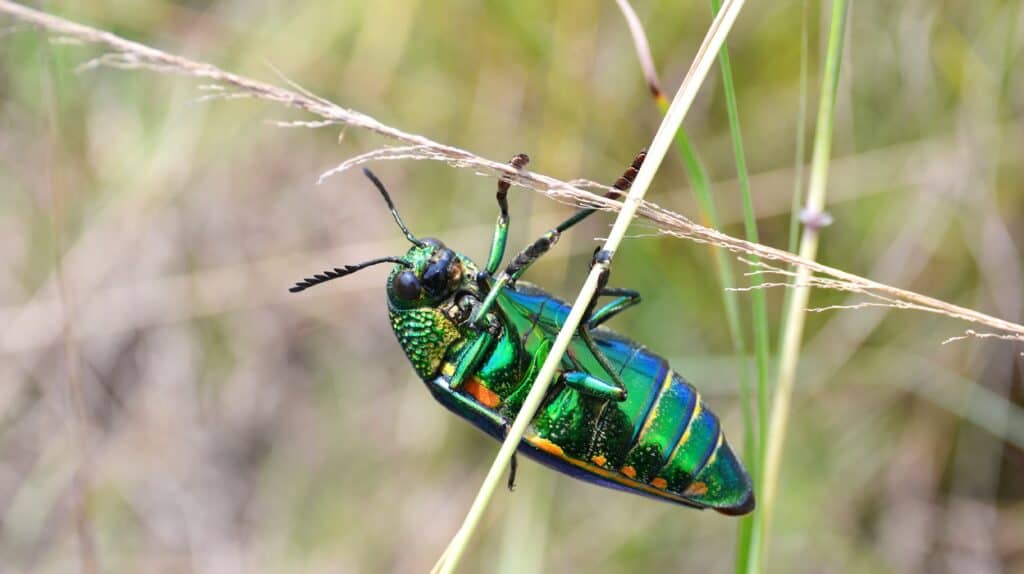Jewel Beetle
They are named Jewel Beetles due to their iridescent wings.
Advertisement
Jewel Beetle Scientific Classification

Jewel Beetle Facts
- Fun Fact
- They are named Jewel Beetles due to their iridescent wings.
- Biggest Threat
- Habitat loss
- Most Distinctive Feature
- Iridescent coloring
Jewel Beetle Physical Characteristics
View all of the Jewel Beetle images!
These iridescent beetles are named for the jewels that they resemble.
The Jewel beetle family is a large grouping of beetles that live all over the world. Some are large and used in decorative jewelry. Others can cause problems with trees and plants. All Jewel beetles have some of the most interesting and unique markings and appearances of insects out there.
Species, Types, and Scientific Name
Jewel beetle is the common name of the family of beetles known as Buprestidae. This family includes at least six genera. Some scientists think that some can be subdivided even further. The genera within the family that are well-established include Agrilinae, Buprestinae, Chrysochroinae, Galbellinae, Julodinae, and Polycestinae. Well-known Jewel beetle species include Chrysochroa Fulminans and the Emerald Ash Borer, or Agrilus planipennis.
Buprestidae falls within the Buprestoidea superfamily. The other family included in this superfamily is the Schizopodidae. All of the beetles in this family do not have a fused coxa and thorax. Jewel beetles are distinct in their appearance, however.
They are in the Polyphaga suborder. This is the largest suborder of beetles and has more than 350,000 distinct species that belong to 144 different families. Around 90% of all beetles that have been discovered and classified fall in this suborder. They have a few physical characteristics that make them distinct from other beetles. These beetles are also valuable members of the ecosystem. They take harmful toxins out of the soil and water where they live. After digesting them, these beetles release nutrients that help the soil and water stay healthy and ready to support other organisms.
Jewel beetles are Coleoptera order. All beetles fall in this category. Beetles are characterized by hard front wings. These are called elytra. Beetles comprise around 40% of insects and 25% of classified animals in the Animalia kingdom. They belong to the Insecta class, Arthropoda phylum, and Animalia kingdom.
Jewel Beetles
| Kingdom | Animalia | |
| Phylum | Arthropoda | |
| Class | Insecta | |
| Order | Coleoptera | |
| Suborder | Polyphaga | |
| Superfamily | Buprestoidea | |
| Family | Buprestidae | |
| Genus | Agrilinae, Buprestinae, Chrysochroinae, Galbellinae, Julodinae, and Polycestinae |
Appearance: How To Identify Jewel Beetles
Jewel beetles have a great name. One of their most distinguishing features is their glossy, jewel-like wings. They aren’t always bright or flashy but have a more iridescent appearance. Some species do have brilliant colors, however. At first glance, they do appear like jewels on trees and branches.
The size of Jewel beetles varies by species and even within subfamilies. The smallest Jewel beetles are around 3 mm long. These tiny beetles are hard to spot. Larger Jewel beetles can be up to 3 inches or more. They make great specimens in insect collections. They are even used in jewelry in some cultures.
Like most beetles, Jewel beetles are generally oval-shaped. They have hard front wings, which is where their interesting coloring appears. The iridescent quality actually comes from the light reflecting in different directions at different frequencies. It is not actually a different pigment or color in their bodies. Instead, it is part of the surface of their wings.

The smallest Jewel beetles measure around 3 millimeters.
©pixbox77/Shutterstock.com
Habitat: Where to Find Jewel Beetles
Jewel beetles are wood-boring insects. They live in many different types of climates, including woodlands, forests, and tropical areas. As long as they have a food source, these beetles can live just about anywhere. They favor plants that are dead and decaying. For this reason, you can often find them around areas with frequent forest fires.
Members of the Buprestidae family can be found on all continents other than Antarctica, including North and South America, Asia, Africa, Europe, and Australia. With over 15,000 species in the family, Jewel beetles can be found in almost every country. However, not all species are found everywhere in the world. Most have a preferred type of tree or plant and are found where those grow. With many species in the Buprestidae family, they are widespread.
Many bug collectors around the world enjoy finding and collecting Jewel beetles. Not only do they look great in a case, but they also have fascinating biology and appearance. Some species are very rare and make a prized specimen in a collection.
One example, the Berlin Jewel Beetle or Golden Jewel Beetle, had not been seen in 15 years. Plant samples taken from the Steigerwald Forest in Germany in 2021 included an egg that hatched in the lab. Scientists were amazed when the Golden Jewel Beetle emerged. Researchers were trying to understand the ecology of beech trees from the region that were dying in large numbers during a 2020 drought. When they found this rare beetle, scientists were happy to learn even more about the forest.
Beetlewing Jewelry
One amazing aspect of Jewel beetles is that they can be used to make unique jewelry. They have colorful, iridescent wings that are also hard. This gave them the name Jewel beetle and also gave people the idea to use them in place of jewels. Most beetlewing items are handcrafted by artisans and no two pieces are exactly identical. Typically, larger species are used. They are particularly popular in India and Thailand. Jewel beetle wings were even used in a circa-1860s dress to create an interesting design.
Diet: What Do Jewel Beetles Eat?
Jewel beetles are wood-boring beetles that eat wood and plants. They lay eggs in dead or decaying wood. When they hatch, larvae go right to work eating. Also called flathead borers, the larvae often favor roots and logs. If you see a fallen log in the forest, there is a good chance that a Jewel beetle or its larvae are having a feast.
Many Jewel beetles like to eat oak, pine, spruce, fir, and hemlock. Some species, such as the Emerald Ash Borer, are named for the type of wood that they like to eat. Jewel beetles can also eat leaves, stems, and grass. They go after just about every part of many plants, although they favor rotting and decaying wood. The species that eat primarily rotten and decayed wood are a valuable part of the ecosystem and not harmful to living plants. However, they do not eat pine needles.
Some species, such as the Emerald Ash Borer, eat live plants. They can cause quite a bit of damage, especially in areas where they are not native. These Jewel beetles bore into the wood of ash trees and eat the layer just under the bark that normally moves nutrients around the tree to keep it alive. By the time people recognize that a tree is infested with Emerald Ash Borers, it is often too late to save the tree.
Prevention: How to Get Rid of Jewel Beetles
While many Jewel beetles are harmless and actually provide some benefit to their environment, it is important not to spread insects to areas where they are not native. They can quickly become an invasive species that feeds on local trees and plants without any natural ways to keep their populations in check. This is exactly what happened as the Emerald Ash Borer spread from its native Asia to other international areas.
There are some natural predators of Jewel beetles. Wasps and dragonflies both eat the larvae and prevent the population from exploding. For a natural solution, try attracting these natural predators to your yard or garden. Just developing a healthy ecosystem can prevent Jewel beetles from wreaking havoc on your plants.
Keeping rotting and decaying logs cleaned up can also deter Jewel beetles. Because they like this food source, if you eliminate it or remove it to an area where the Jewel beetles won’t disturb other plants, you can keep them from taking over. Make sure that any compost or soil that you use is fully decayed.
If you already have a Jewel beetle problem, chemical pesticides are effective at getting rid of adult Jewel beetles and larvae. Just be sure to double-check to ensure that they won’t harm other beneficial insects or your own plants. Many people who garden and eat their own vegetables and fruits try to avoid using chemical sprays and pesticides.
Up next:
- 10 Incredible Dung Beetle Facts
- The 9 Most Colorful Beetles in the World
- 10 Most Beautiful Insects in the World
Jewel Beetle FAQs (Frequently Asked Questions)
Are Jewel beetles dangerous?
No, these beetles do not pose a threat to people or animals. They can cause damage to some plants when they are an invasive species without any natural predators to keep their population in check.
How many legs does a Jewel beetle have?
All beetles, including Jewel beetles, have 6 legs. As larvae, they do not have any legs.
How do you identify a Jewel beetle?
The easiest way to identify a Jewel beetle is from the iridescent coloring of its hard front wings. Some are brightly colored, such as the Emerald Ash Borer that is emerald-colored. Others are gold, brown, or darker colors.
Thank you for reading! Have some feedback for us? Contact the AZ Animals editorial team.
Sources
- KidADL, Available here: https://kidadl.com/facts/animals/jewel-beetle-facts
- Waldwissen, Available here: https://www.waldwissen.net/en/forest-ecology/forest-fauna/insects-invertebrates/red-listed-jewel-beetle-re-discovered#:~:text=To%20their%20surprise%2C%20what%20emerged,more%20than%2015%20years%20earlier.
- Beading Gem, Available here: https://www.beadinggem.com/2020/09/unusual-jewelry-made-from-jewel-beetle.html#:~:text=These%20prized%20insects%20are%20very,used%20in%20the%20decorative%20arts.
- Victoria & Albert Museum, Available here: https://www.vam.ac.uk/exhibitions/fashioned-from-nature
- USDA Forest Service, Available here: https://www.nrs.fs.fed.us/disturbance/invasive_species/eab/biology_ecology/planipennis/#:~:text=The%20emerald%20ash%20borer%20(%20EAB,Michigan%20and%20nearby%20Windsor%2C%20Ontario.
















